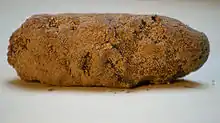| Tyrophagus casei | |
|---|---|
_-_Mites_-_Collection_Anthonie_Cornelis_Oudemans.jpeg.webp) | |
| Scientific classification | |
| Domain: | Eukaryota |
| Kingdom: | Animalia |
| Phylum: | Arthropoda |
| Subphylum: | Chelicerata |
| Class: | Arachnida |
| Order: | Sarcoptiformes |
| Family: | Acaridae |
| Genus: | Tyrophagus |
| Species: | T. casei |
| Binomial name | |
| Tyrophagus casei | |
| Synonyms | |
|
Tyrolichus casei Oudemans, 1910 | |
Tyrophagus casei, the cheese mite, is a species of mite which is inoculated into Milbenkäse and Altenburger Ziegenkäse cheese during their production. It is 0.45–0.70 millimetres (0.018–0.028 in) long, and feeds on cheese, corn, flour, old honeycombs, bird collections, and smoked meats.[2]
The surface of cheese which has been colonised by mites may be covered with a fine, grey powder or bloom, due to the mites themselves and their moulted skin and faeces. These impart a distinctive "piquant" taste to various cheeses.[3]
 An aged Milbenkäse – cheese matured using cheese mites
An aged Milbenkäse – cheese matured using cheese mites
See also
- Cheese mite
- Cheese fly or cheese skipper, Piophila casei
References
- ↑ "Tyrophagus casei (Oudemans, 1910)". Encyclopedia of Life. Retrieved August 3, 2011.
- ↑ Thomas Scott (1996). "Acari". Concise Encyclopedia: Biology. Walter de Gruyter. pp. 6–7. ISBN 3-11-010661-2.
- ↑ "Mites". www.the-piedpiper.co.uk.
External links
- Finlo Rohrer (May 29, 2008). "Cheese mites and other wonders". BBC News. Includes The Cheese Mites (1903), the first science documentary meant for the public.
- A Parable by Sir Arthur Conan Doyle, at Wikisource
- The Dying Whip by Sir Arthur Conan Doyle, at Wikisource
- From a College Window by Arthur Christopher Benson, at Project Gutenberg
This article is issued from Wikipedia. The text is licensed under Creative Commons - Attribution - Sharealike. Additional terms may apply for the media files.
